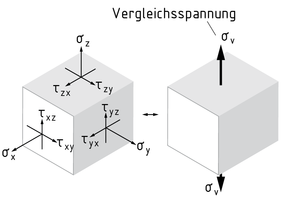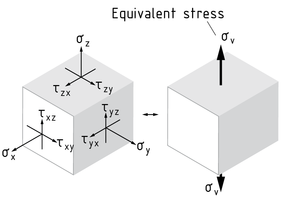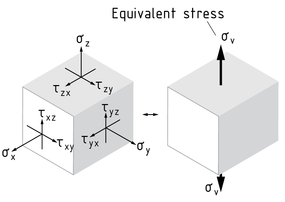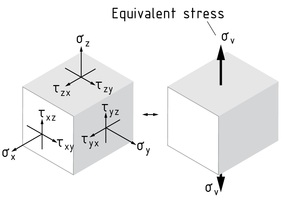
Wählen Sie eine
oder mehrere Sprachen aus
0,1,0
- Deutsch
- Englisch
- Chinesisch
- Spanisch
Normalspannungshypothese

Die Normalspannungshypothese ist eine Festigkeitshypothese, bei der die größere auftretende Hauptnormalspannung ${{\sigma }_{1}}$ mit der Vergleichsspannung ${{\sigma }_{v}}$gleichgesetzt wird, um über die maximale Tragfähigkeit eines mehrachsig belasteten Bauteiles zu bestimmen.
Der mehrachsige Spannungszustand wird durch eine repräsentative Vergleichsspannung ${{\sigma }_{v}}$ ersetzt. Die Tragfähigkeit des Bauteils kann dann aus den Messwerten eines Zugversuches (Streckgrenze/Zugfestigkeit und Materialwerte) bestimmt werden.
Diese Hypothese ist bei Werkstoffen mit spröden Eigenschaften oder Bauteilen, welche Stoßartig belastet werden, anwendbar. Das Versagen des Bauteils wird in Form eines Trennbruchs mit geringer plastischer Verformung erfolgen, sodass die größte auftretende Normalspannung für den Bruch verantwortlich ist.
Maximum stress theory

The maximum stress theory is a failure theory whereby the greater principal normal stress ${{\sigma }_{1}}$ occurring is equated to the equivalent stress ${{\sigma }_{v}}$to determine the maximum load-Bearing capacity of a component subjected to multiaxial stresses.
The multiaxial state of stress is replaced by a representative equivalent stress ${{\sigma }_{v}}$. The component's load-bearing capacity can then be determined from the values measured during a tensile test (yield point/tensile Strength and Material values).
This theory can be used for materials with brittle properties or components subjected to impact stresses. Component failure takes the form of a separation fracture with a small amount of plastic deformation, which means the greatest Normal stress occurring is responsible for the rupture.
最大拉应力理论

最大拉应力理论描述了材料失效与最大拉应力的关系,其中最大法向主应力 ${{\sigma }_{1}}$ 等于其相当应力 ${{\sigma }_{v}}$ ,可以确定多轴应力状态下的材料的强度极限。
多轴应力状态通过相当应力 ${{\sigma }_{v}}$ 来代替。然后就可以根据拉伸试验的测量值(屈服点/拉伸强度和材料系数)确定材料的强度极限。
这一理论适用于脆性材料或受冲击应力的材料。由于众多微量的塑性变形引起材料的断裂失效,所以作用于材料的最大正应力是引起材料断裂失效的主要因素。
最大拉应力理论中的相当应力
Teoría del esfuerzo máximo

La teoría del esfuerzo máximo es una teoría de falla en la cual el mayor esfuerzo normal principal ${{\sigma }_{1}}$ que se produce se iguala al esfuerzo equivalente ${{\sigma }_{v}}$ para determinar la capacidad de carga máxima de un componente sujeto a esfuerzos multiaxiales.
El estado de esfuerzo multiaxial es reemplazado por un esfuerzo equivalente ${{\sigma }_{v}}$ representativo. La capacidad de carga máxima puede ser entonces determinada a partir de los valores que se miden durante una prueba de tensión (valores del material y de límite de elasticidad/resistencia a la tracción).
Esta teoría puede usarse para materiales con propiedades quebradizas o componentes sujetos a esfuerzos de impacto. La falla del componente toma la forma de una fractura de separación con una cantidad pequeña de deformación plástica, lo que significa que el mayor esfuerzo normal que se produce es responsable de la ruptura.
Esfuerzo equivalente en la teoría del esfuerzo máximo
